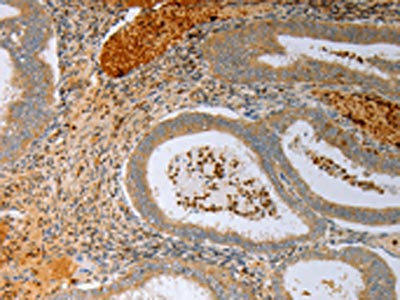Description
| Antibody Name: | FOXN1 Antibody (PACO17902) |
| Antibody SKU: | PACO17902 |
| Size: | 50ul |
| Host Species: | Rabbit |
| Tested Applications: | ELISA, IHC |
| Recommended Dilutions: | ELISA:1:1000-1:5000, IHC:1:25-1:100 |
| Species Reactivity: | Human |
| Immunogen: | Synthetic peptide of human FOXN1 |
| Form: | Liquid |
| Storage Buffer: | -20°C, pH7.4 PBS, 0.05% NaN3, 40% Glycerol |
| Purification Method: | Antigen affinity purification |
| Clonality: | Polyclonal |
| Isotype: | IgG |
| Conjugate: | Non-conjugated |
 | The image on the left is immunohistochemistry of paraffin-embedded Human cervical cancer tissue using PACO17902(FOXN1 Antibody) at dilution 1/15, on the right is treated with synthetic peptide. (Original magnification: x200). |
| Background: | Mutations in the winged-helix transcription factor gene at the nude locus in mice and rats produce the pleiotropic phenotype of hairlessness and athymia, resulting in a severely compromised immune system. This gene is orthologous to the mouse and rat genes and encodes a similar DNA-binding transcription factor that is thought to regulate keratin gene expression. A mutation in this gene has been correlated with T-cell immunodeficiency, the skin disorder congenital alopecia, and nail dystrophy. Alternative splicing in the 5' UTR of this gene has been observed. |
| Synonyms: | forkhead box N1 |
| UniProt Protein Function: | FOXN1: Transcriptional regulator involved in development. Defects in FOXN1 are the cause of T-cell immunodeficiency congenital alopecia and nail dystrophy (TIDAND). A disorder characterized by the association of congenital alopecia, severe T-cell immunodeficiency, and ridging and pitting of all nails.Protein type: DNA-binding; Transcription factor; Cell development/differentiationChromosomal Location of Human Ortholog: 17q11.2Biological Process: defense response; epidermis development; organ morphogenesis; regulation of transcription from RNA polymerase II promoter; transcription from RNA polymerase II promoterDisease: T-cell Immunodeficiency, Congenital Alopecia, And Nail Dystrophy |
| UniProt Protein Details: | |
| NCBI Summary: | Mutations in the winged-helix transcription factor gene at the nude locus in mice and rats produce the pleiotropic phenotype of hairlessness and athymia, resulting in a severely compromised immune system. This gene is orthologous to the mouse and rat genes and encodes a similar DNA-binding transcription factor that is thought to regulate keratin gene expression. A mutation in this gene has been correlated with T-cell immunodeficiency, the skin disorder congenital alopecia, and nail dystrophy. Alternative splicing in the 5' UTR of this gene has been observed. [provided by RefSeq, Jul 2008] |
| UniProt Code: | O15353 |
| NCBI GenInfo Identifier: | 13124629 |
| NCBI Gene ID: | 8456 |
| NCBI Accession: | O15353.1 |
| UniProt Secondary Accession: | O15353,O15352, B2R9Q7 |
| UniProt Related Accession: | O15353 |
| Molecular Weight: | 68,925 Da |
| NCBI Full Name: | Forkhead box protein N1 |
| NCBI Synonym Full Names: | forkhead box N1 |
| NCBI Official Symbol: | FOXN1 |
| NCBI Official Synonym Symbols: | WHN; RONU; FKHL20 |
| NCBI Protein Information: | forkhead box protein N1 |
| UniProt Protein Name: | Forkhead box protein N1 |
| UniProt Synonym Protein Names: | Winged-helix transcription factor nude |
| Protein Family: | Forkhead box protein |
| UniProt Gene Name: | FOXN1 |
| UniProt Entry Name: | FOXN1_HUMAN |






